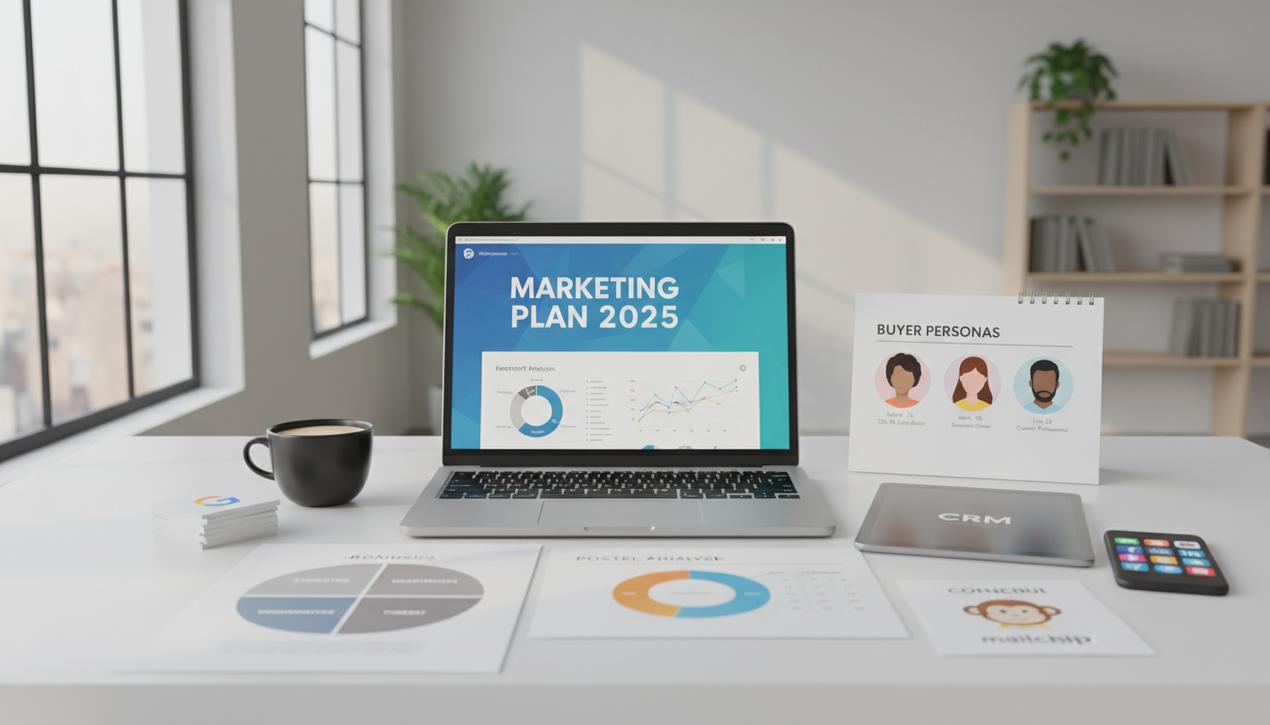Marketing Plan 2025: The Complete 8-Step Guide


Navigating today’s competitive ocean without a precise map is the surest way to drift. In marketing, this map is called a marketing plan. It’s the strategic roadmap that transforms ambitions into measurable actions. The statistics for 2025 are clear: organizations that document their strategy in a formal marketing plan are over 300% more likely to report success. Yet, nearly half of all small businesses are still operating without a structured plan. This lack of planning isn’t just an oversight; it’s a major strategic risk that limits growth and exposes them to unforeseen threats. A solid marketing plan is more than just a document; it’s a dynamic process that aligns your teams, optimizes your resources, and maximizes your return on investment. This comprehensive guide details the 8 essential steps to build an unbeatable marketing plan that will propel your business toward success.
What Is a Marketing Plan and Why Is It Essential?
A marketing plan is an operational document that details your marketing strategy for a specific period, typically one year. It outlines not only the actions to be taken but also the objectives to be achieved, the audience to be targeted, the budget to be allocated, and the key performance indicators (KPIs) to be tracked. Far more than a simple to-do list, it serves as a common reference for all teams (sales, communications, product) and ensures that every action taken contributes to the company’s overall vision. In 2025, where budgets are under intense scrutiny, a well-designed marketing plan justifies every dollar spent and demonstrates marketing’s direct contribution to revenue growth.
The 8 Steps to Building an Unbeatable Marketing Plan
Creating an effective marketing plan follows a rigorous logic, starting from a broad analysis and culminating in a detailed action plan. Here are the 8 essential steps to follow.
1. Situational Analysis: SWOT, PESTEL, and Competition
Before you can decide where you’re going, you need to know where you stand. This first step involves a complete diagnosis of your position in the market.
- SWOT Analysis: This is the fundamental tool for evaluating your internal factors (Strengths, Weaknesses) and external factors (Opportunities, Threats). Your strengths are your competitive advantages, while weaknesses are areas for improvement. Opportunities are market trends you can exploit, and threats are potential obstacles.
- PESTEL Analysis: To deepen the external analysis, the PESTEL model (Political, Economic, Sociocultural, Technological, Environmental, Legal) is indispensable. It helps identify macro-environmental trends that could impact your industry.
- Competitive Analysis: Who are your direct and indirect competitors? What are their strategies, strengths, and weaknesses? Using competitive analysis tools will give you a clear view of the landscape and help you identify your distinct advantage.
2. Define Your Mission and SMART Goals
Once the analysis is complete, you must translate your ambitions into clear, measurable objectives. Start by defining your marketing mission: what are you trying to accomplish? Then, break this mission down into SMART goals:
- Specific: “Increase website traffic” is too vague. “Increase organic traffic by 20%” is specific.
- Measurable: Every goal must be quantifiable.
- Achievable: Set ambitious but realistic goals given your resources.
- Relevant: Ensure each marketing goal contributes to the company’s overall business objectives.
- Time-bound: Every goal must have a clear deadline (e.g., “by the end of Q3”).
Examples of goals include generating 500 qualified leads per month, increasing e-commerce conversion rates by 15% in six months, or boosting brand awareness by 10% among the 25-35 age demographic.
3. Identify and Segment Your Target Audience (Buyer Personas)
A message aimed at everyone speaks to no one. The success of your plan depends on your ability to precisely understand your customers. The buyer persona method is the most effective way to do this. It involves creating semi-fictional profiles of your ideal customers based on demographic and, more importantly, psychographic data (motivations, pain points, goals, challenges). A well-defined persona will help you choose the right channels, create compelling messages, and develop products that meet a real need.
4. Craft Your Unique Value Proposition (UVP)
Your unique value proposition is the clear, concise answer to the question every potential customer asks: “Why should I buy from you instead of a competitor?”. It must highlight the primary benefit you offer, what makes you unique, and why you are desirable. A strong UVP isn’t just a slogan; it’s the cornerstone of your marketing message and should be reflected in all your communications.
5. Define Your Content Strategy and Distribution Channels
Content is the fuel for your marketing engine. Your content strategy should define the topics you will cover, the formats you will use (blog posts, videos, podcasts, infographics and visual content, etc.), and a publication schedule. Next, choose the most relevant distribution channels to reach your personas. In 2025, an omnichannel approach is king.
- Content Marketing and SEO: Search Engine Optimization remains the channel with the best long-term ROI for attracting qualified traffic.
- Social Media: Choose platforms where your audience is most active. Short-form video (Reels, TikTok) continues to dominate in terms of engagement.
- Email Marketing: Email remains an extremely powerful channel for conversion and retention, boasting a very high average ROI.
- Paid Advertising (SEA, Social Ads): Ideal for achieving quick results and precise targeting.
6. Establish the Marketing Mix: The 7Ps
The marketing mix is the set of tactical tools you will use. The traditional 4Ps model has been expanded to the 7Ps to include services:
- Product: What are the features and benefits of your offering?
- Price: What is your pricing strategy?
- Place (Distribution): How do customers access your product or service?
- Promotion: How will you communicate your offering to your target audience?
- People: How does your team interact with customers? The human experience is a key differentiator.
- Process: What is the customer journey, from discovery to post-purchase support? Is it smooth and efficient?
- Physical Evidence: What tangible elements reassure the customer (e.g., your website design, packaging, customer testimonials)?
7. Allocate Budget and Resources
This step involves putting numbers to your plan. Allocate your overall marketing budget across the various channels and actions you’ve planned. In 2025, companies allocate an average of 50-60% of their marketing budget to digital channels. Don’t forget to include costs for tools (CRM, email marketing platform, etc.), agency or freelancer fees, and your team’s salaries. A well-structured budget should include funds for ongoing activities as well as for experimenting with new channels.
8. Define KPIs and a Monitoring Plan
“You can’t improve what you don’t measure.” The final step is to define the key performance indicators (KPIs) that will allow you to track the effectiveness of each action. Every SMART goal should have associated KPIs. For example, for a lead generation goal, you would track the number of leads, cost per lead (CPL), and conversion rate. Set up a dashboard (using Google Analytics or a BI tool) and schedule regular reviews (weekly or monthly) to analyze results, understand what’s working, and adjust your strategy accordingly.
A marketing plan is not a static document destined to collect dust. It is an agile management tool, a compass that guides your daily decisions. By following these 8 steps, you won’t just be planning actions; you will be building a true growth engine that is resilient and aligned with the realities of your market. The planning requires an initial effort, but it is the most profitable investment you can make to ensure the future and success of your company.




